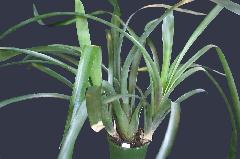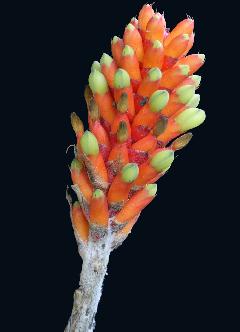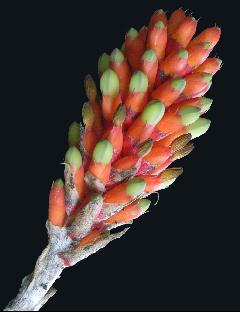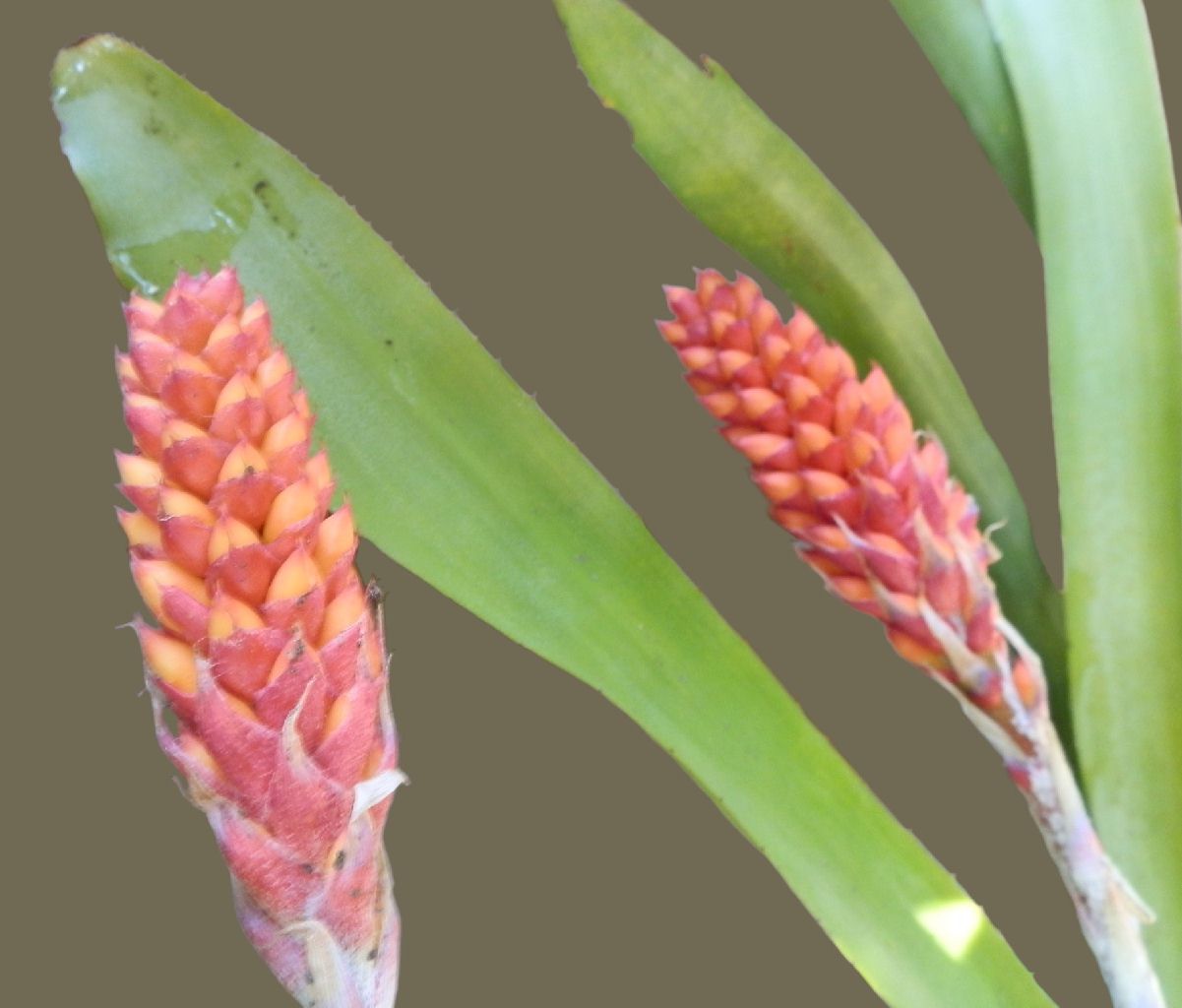



Aechmea blumenavii var. alba Reitz Bromeliaceas e a malaria-bromelia endemica 412-3. 1983
Differs from Type by having white petals
Type Brasil, Santa Catarina; Brusque, R Reitz 7409, 7 Sept. 1970, HBR
From Bromeliaceas by Reitz 1983
10a. AECHMEA BLUMENAVII Reitz var. BLUMENAVII
GRAVATA-DE-BLUMENAU
Est. 3
Reitz, Anais Bot. Herb. Barbosa Rodrigues 4: 21, thb. 6. 1952, loc. cit. 4¬37. 1952, loc. cit. 4: 48. 1952, Sellowia 7: 124. 1956, loc. cit. 13: 79. 1961, loc. cit. 17: 45. 1965, loc. cit. 19: 101. 1967, Anais XV Congr. Nac. Bot. 236. 1967; L. B. Smith & R. J. Downs, Flora Neotropica 14 (3): 1877, fig. 638 G-J. 1979.
EPIFITO, acaule, florifero, 0.5-0,7m de altura. FOLHAS 10-15, dispostas em roseta, reunidas embaixo formando cisterna; BAINHA evidente, suboval, amplexicaule, integerrima, escamada, violacea da metade ate o apice; LAMINA rija, subereta, das folhas exteriores pouco recurvo-patente, acanalado-concava, na margem com espinhos m. ou m. iguais, de 0,5mm de compr., castanhos, virados para cima, distantes por l0mm, exceto no apice onde sao mais densamente reunidos, quase nada estreitada sobre a bainha, arredondada no apice, terminada em mucro pequeno, filiforme, herbaceo, nao pungente, largamente linear, 0,40-0,70m de compr., m. ou m. 4cm de larg., escamada de ambos os lados, um pouco transversalmente zebrada (especialmente na forma esciofita) verde, de apice violaceo-negro.
INFLORESCENCIA multi ou submultifloral, sublaxa, espigada para qualquer lado, cilindrica, muitas flores aqui ou ali subverticiladamente afixas, simplicissima, truncada no apice, antese a comecar da base para o apice com eixo visivel, superado pelas folhas, nos exemplares esciofilos menor que as folhas e nos heliofilos maior; ESCAPO quase glabro, violaceo-escuro; FOLIOLOS muito tenros, ja secos na antese, esbranquicados, semiamplexicaules, subovados, acuminado-agudos, integerrimos, pouco numerosos, os inferiores mais laxamente dispostos, distantes por 12cm, colados no escapo; RAQUE densamente branco-escamada, sulcada, rosea; BRACTEAS roseas, abracam por 1/4 parte o ovario, planas, bem triangulares, acuminadas para o apice, terminadas em mucro filiforme, herbaceo, menores que os sepalos, com excecao das basais que sao iguais ou maiores que os sepalos, pouco branco-tomentosas, longitudinalmente venosas, integerrimas, as medianas 11mm de compr., 3mm de largura na base. FLORES m. ou m. 16, sesseis; SEPALOS roseos, apice roseo-flavescente, pouco branco-tomentosos, concrescidos em tubo ate a metade, dali para cima livres, eretos, bem convolutos, lado direito alargado em grande asa membranacea, terminados em espi¬nho subereto, roseo-amarelado, 3mm de compr., muito assimetricos, m. ou m. 4mm de compr. (sem o espinho), 3mm de larg. ; PETALOS belamente amarelos, livres ate a base, ai separados pelos fila-mentos interpetaleos, capuciconcavos, simetricos, bem abertos na antese, incluindo as partes genitais, subovados, de apice largamente arredondado, emarginado, atenuados para a base, com 2 LIGULAS curtas a lmm da base, pouco fimbriadas, 2 calos evidentes; ESTAMES 1mm menores que os petalos; FILAMENTOS amarelos, bem complanado-lineares, muito dilatados para o apice, os interpetaleos livres, os epipetaleos concrescidos ate 2mm de altura, depois correm presos entre os calos; ANTERAS amarelas, 3,5mm de compr., agudas de ambos os lados, pouco mais largas que os filamentos, dorsifixas exatamente no meio; GRAOS DE POLEN elipsoides, biporados; OVARIO 6mm de compr., pouco tomentoso, subgloboso cilindrico, quase nada anguloso, pouquissimo estreitado na base dos sepalos; TUBO EPIGINO evidente, infundibuliforme; ESTILETE quase tao alto como as anteras, filiforme, pouco engrossado para o apice; ESTIGMA com lobos pouco divididos, contortos; PLACENTA afixa no meio do angulo interno dos loculos; OVULOS numerosos, de apice obtuso, nao apendiculados.
BAGA formada do ovario um pouco engrossado, coroada pelos sepalos persistentes. SEMENTES ovoideas, m. ou m. 2mm de com¬primento.
Tipo - Brasil, Santa Catarina: Blumenau, Morro Spitzkopf, epifita da mata primitiva, 500m, R. Reitz 4679 (20.03.1952), holotipo, HBR.
Nomes vulgares - Gravata-de-blumenau, monjola, bromelia.
Dados fenologicos - Foi encontrada em flor nos meses de Ja¬neiro, abril, maio, junho, outubro e novembro.
Observacoes ecologicas - Planta epifita ou raramente rupestre, florifera de 50 a 70cm de altura, de poucas folhas (10-15) dispostas em roseta funiliforme, reunidas embaixo formando pequeno receptaculo; laminas rijas, suberetas, das folhas exteriores pouco recurvo¬patentes, acanalado-concavas, nas margens com pequenos espinhos castanhos, virados para cima, distanciados por 10mm, sendo mais densamente reunidas no apice, terminando em mucro pequeno nao pungente, largamente lineares, medindo de 40 a 70cm de compr. e cerca de 4cm de larg., com escamas de ambos os lados, um pouco transversalmente zebradas (especialmente nas formas esciofitas), verdes e de apice violaceo-negro;. inflorescencia em espiga sublaxa cilindrica multi ou submultifloral, flores sesseis com sepalos roseos e petalos belamente amarelos; semelhante a Ae. kertesziae da qual se distingue principalmente pelas folhas mais estreitas (lineares) e pela inflorescencia mais delicada; caracteristica e exclusiva, da Floresta Pluvial da Encosta Atlantica, onde apresenta pouco expressiva, descontinua e nao muito ampla dispersao. Ate o momento endemica, encontrada somente no Estado de Santa Catarina.
Especie de luz difusa ou heliofita, pouco frequente, ocorre no interior das florestas primarias das encostas, preferencialmente afixada nos troncos das arvores, em altitudes compreendidas entre 40 e 900 metros. No Vale do Itajai ocorrem em media 2 exemplares por 100 metros quadrados.
Pelo Instituto de Malariologia de Brusque foram analisados 339 exemplares desta especie, constatando-se uma altura media de afixacao de 6,70 metros acima do solo, estando 59,00% afixados nos troncos, 23,60% nos galhos e 17,40% sobre o humus; foi encontrado um maximo de 250cm^3 e uma media anual de 46cm^3 de agua contida no imbricamento das folhas; quanto a luz 89,65% eram de luz difusa, 8,25% expostos a luz direta e apenas 2,10% tolerantes a sombra; quanto a sociabilidade predominou o agrupamento de 2 a 5 exemplares com 45,90%; seguindo-se o agrupamento acima de 10 exemplares com 33,45%; sendo 14,40% de 6 a 10 exemplares e apenas 6,25 foram encontrados de forma isolada.
Material estudado - SANTA CATARINA: ANTONIO CARLOS: Fachinal, epifito da mata, 500m, flor, R. Reitz C951 (18.01.1945), HBR; ibidem, 600m, flor, R. Reitz 0929 (17.01.1945), HBR. BOTUVERA: Ribeiriio do Ouro, epifito da mata, 640m, flor, R. Reitz 3559a (08.05.1950), HBR; ibidem, 640m, flor, R. Reitz 3559 (08.05.1950), HBR, US; ibidem, R. Reitz 3638 (-.05.1950), HBR; ibidem, 850m, R. Reitz 3639 (-.05.1950), HBR. BLUMENAU: Morro Spitzkopf, epifito da mata, 500m, R. Reitz 4679 (20.03.1952), HBR; ibidem, 200m, R. Reitz 2300 (02.11.1948), HBR. BRUSQUE: perto da cidade, epifito da mata, 400m, flor, R. Reitz 3530 (16.09.9510), HBR. IBIRAMA: Horto Florestal do Inst. Nac. do Pinho, flor, 550m, R. Reitz & R. M. Klein 3870 (11.10.1956), HBR. ILHOTA: Morro Bail, epifito da mata, 500m, R. Reitz 4743 (08.01.1952), HBR. ITAJAI: Morro da Fazenda, epifita da mata, 30m, R. Reita & R. M. Klein 1823 (28.04.1954), HBR. LUIZ ALVES: Braco Joaquim, epifito da mata, 350m, flor, R. Reitz & R. M. Klein 3360 (21.06.1956), HBR. ORLEAES: Santa Clara, rupestre, 95m, flor, R. Reitz C1745 (28.11.1946), HBR. PORTO BELO: Canto Grande, rupestre da mata, 40m, R. Reitz 3621 (15.07.1950), HBR. PRESIDENTE NEREU: Sabili, epifito da mata, 750m, R. Reitz & R. M. Klein 4272 (14.06.1957), HBR; ibidem, 750m, flor, R. Reitz & R. M. Klein 6652 (07.04.1958), HBR. RIO DO SUL: Matador, A. Lourteig 2322 (17.12.1967), P; 2387 (P, US).
Area de dispersao - SANTA CATARINA: nos municipios de An¬tonio Carlos, Botuvera, Blumenau, Brusque, Ibirama, Ilhota, Itajai, Luiz Alves, Orleaes, Presidente Nereu e Rio do Sul.
BRASIL: ate o momento so encontrada em Santa Catarina., Utilidade - Planta ornamental.
Nota, endemiologica - Face a seu pequeno volume medio anual de agua (46cm^3) contido no imbricamento das folhas e sua baixa frequencia, aliada ainda, ao baixo indice de positividade ou seja de 0,1%, isto e, menos de 1 individuo positivo em 1.000 pesquisados, esta especie nao apresenta valor endemiologico para a regiao estudada.
l0b. AECHMEA BLUMENAVII Reitz var. ALBA* Reitz nov. var.
GRAVATA
A typo petalis albis differt.
Typus - Brasil, Santa Catarina: Brusque, R. Reitz 7409, 7 Sept. 1970, HBR.
A nova variedade aqui descrita difere de Aechmea blumenavii Reitz apenas por apresentar petalos brancos em vez de amarelos.
Observacoes ecologicas - Planta quanto ao aspecto vegetativo identico a var. tipica e da qual difere apenas por apresentar petalos brancos em vez de amarelos, nao sendo portanto possivel distingui-la sem flores; caracteristica e exclusiva da Floresta Pluvial Atlantica, onde possivelmente e muito rara, com dispersao restrita e inexpressiva. Ate o momento so encontrada no municipio de Brusque, Vale do Itajai, Santa Catarina.
Material estudado - SANTA CATARINA: BRUSQUE: perto da cidade, petalos brancos, R. Reitz 7409 (07.09.1970), HBR, holotipo.
Nomes vulgares - Gravata, bromelia, monjola.
Area de dispersao - SANTA CATARINA: ate o momento so en¬contrada no municipio de Brusque.
Utilidade - Planta decorativa.
translated by Butcher
10a. AECHMEA BLUMENAVII Reitz var. BLUMENAVII
GRAVATA-DE-BLUMENAU
Est. 3
Reitz, Anais Bot. Herb. Barbosa Rodrigues 4: 21, thb. 6. 1952, loc. cit. 4¬37. 1952, loc. cit. 4: 48. 1952, Sellowia 7: 124. 1956, loc. cit. 13: 79. 1961, loc. cit. 17: 45. 1965, loc. cit. 19: 101. 1967, Anais XV Congr. Nac. Bot. 236. 1967; L. B. Smith & R. J. Downs, Flora Neotropica 14 (3): 1877, fig. 638 G-J. 1979.
EPIPHYTE, acaulis, floriferous, height 0.5-0,7m.
LEAVES 10-15, disposed in a rosette, gathered together forming a cistern below;
SHEATHS evident, suboval, amplexicaule, entire, scaled, violet in the top half;
BLADES tough, suberect, external leaves a little recurved spreadind, grooved-concave, margin with thorns ca same, 0,5mm.long, chestnut brown, facing upwards, l0mm apart, except in the apex where they are more densely together, almost not narrowed at the sheath, rounded at the apex, ending in a small mucro, filiforme, herbaceous, not pungent, broad linear, 0.40-0.70m. long, ca 4cm wide, scaled on both sides, a little obliquely banded (especially in the sclerophyll form) green, with violet-black apex.
INFLORESCENCE multi or submultifloral, sublax, spike in any direction, cylindrical, many flowers randomly attached subverticillate, simple, truncated at the apex, anthesis starts from the base to the apex with visible axis, exceeded by the leaves, in the sclerophyll types smaller than the leaves and in the heliophyte types larger;
SCAPE glabrous, dark violet;
SCAPE BRACTS very tender, already dry at anthesis, whitish, semiamplexicaule, subovate, acuminate-acute, entire, a little numerous, the lower ones more lax, 12cm apart, agglutinated to the scape;
RACHIS densely white-scaled, rose;
BRACTS rose, enclosing 1/4 of the ovary, flat, very triangular, acuminate at the apex, ending in a filiform mucro, herbaceous, smaller than the sepals, except for the basal ones that are the same or longer than the sepals, a little white-tomentose, longitudinally veined, entire, the middle ones 11mm long, 3mm wide at in the base.
FLOWERS ca 16, sessile;
SEPALS rose, apex rose-yellowish, a little white tomentose, connate in a tube to halfway then free, erect, well convoluted, right side enlarged in a large membranaceous wing, ending in a suberect spine, rose-yellowish, 3mm long, very asymmetrical, ca 4mm long. (without the spine), 3mm wide;
PETALS beautiful yellow, free from the base, then separate from the interpetalous filaments, hooded concave, symmetrical, very open at anthesis, genitalia included, subovate, broadly rounded apex, emarginate, narrowed at the base, with 2 short LIGULES to lmm from the base, a little fimbriate, 2 evident calluses;
STAMENS 1mm smaller than the petals;
FILAMENTS yellow, very complanate-linear, very wide at the apex, interpetalous ones free, the epipetalous ones adnate to 2mm high, later they run joined amongst the calluses;
ANTHERS yellow, 3,5mm long, acute on both sides, a little wider than the filaments, dorsifixed exactly in the middle;
GRAINS OF POLLEN ellipsoid, biporate;
OVARY 6mm long, a little tomentose, cylindrical subglobose, almost angular, very little narrowed at the base of the sepals;
EPIGYNOUS TUBE evident, infundibuliform;
STYLE almost as high as the anthers, filiform, a little thickened at the apex;
STIGMA with lobes a little divided, contorted;
PLACENTA attached in the middle of the internal angle of the locules;
OVULES numerous, with obtuse apex, no appendages.
BERRY formed of a little thickened ovary, crowned by the persistent sepals.
SEEDS ovoid ca. 2mm lomg.
Type - Brazil, Santa Catarina: Blumenau, Morro Spitzkopf, epiphytic in primitive forest, 500m, R. Reitz 4679 (20.03.1952), holotype, HBR.
Common names - Gravata-de-blumenau, monjola, bromelia.
Phenology – Flowers in Jan, April, May,. June, Oct. & Nov..
Ecological observations - Plants epiphytic or rarely rupestral, flowering from 50 to 70cm high, few leaves (10-15) disposed in a funnel rosette, gathered together forming a small receptacle below; blades tough, suberect, outer leaves a little recurved spreading, grooved-concave, the margins with small brown spines, facing upwards, 10mm apart, more densely together towards the apex, ending in a non-pungent small mucro, broad linear, from 40 to 70cm long and about 4cm wide, with scales on both sides, a little obliquely banded (especially in the sclerophyll), green with violet-black apex;. inflorescence a spike sublax cylindrical multi or submultifloral, flowers sessile with rose sepals and petals a beautiful yellow; similar to Ae. kertesziae from which it differs mainly by the most narrow leaves (linear) and for the most delicate inflorescence; characteristic and exclusive, to the Floresta Pluvial da Encosta Atlantica, where it grows in small patches, discontinuous and not very widely dispersed. At the moment it is only endemic and found in the State of Santa Catarina.
Species of diffuse light or heliophytic, little frequent, occur inside the coastal primary forests, preferably affixed to tree trunks, at altitudes understood between 40 and 900 meters. In the Vale do Itajai it has been measured that there are specimens for 100 square metres.
For the Institute of Malariologia of Brusque 339 specimens of this species were analyzed, those attached 6,70 meters above the soil, being 59,0% stuck on the trunks, 23,60% on the branches and 17,40% on humus; they were found at a maximum rainfall of 250cm and one measured mid year at 46cm caused imbrication of the leaves; as for light 89,65% was of diffuse light, 8,25% exposed the direct light and scarcely 2,10% tolerant to shadow; as for sociability groupings from 2 to 5 specimens were 45,90%; being followed by grouping above 10 specimens at 33,45%; 14,40% from 6 to 10 specimens and only 6,25 were found singularly.
Material studied - SANTA CATARINA: ANTONIO CARLOS: Fachinal, epifito da mata, 500m, flor, R. Reitz C951 (18.01.1945), HBR; ibidem, 600m, flor, R. Reitz 0929 (17.01.1945), HBR. BOTUVERA: Ribeiriio do Ouro, epifito da mata, 640m, flor, R. Reitz 3559a (08.05.1950), HBR; ibidem, 640m, flor, R. Reitz 3559 (08.05.1950), HBR, US; ibidem, R. Reitz 3638 (-.05.1950), HBR; ibidem, 850m, R. Reitz 3639 (-.05.1950), HBR.
BLUMENAU: Morro Spitzkopf, epifito da mata, 500m, R. Reitz 4679 (20.03.1952), HBR; ibidem, 200m, R. Reitz 2300 (02.11.1948), HBR. BRUSQUE: perto da cidade, epifito da mata, 400m, flor, R. Reitz 3530 (16.09.9510), HBR. IBIRAMA: Horto Florestal do Inst. Nac. do Pinho, flor, 550m, R. Reitz & R. M. Klein 3870 (11.10.1956), HBR. ILHOTA: Morro Bail, epifito da mata, 500m, R. Reitz 4743 (08.01.1952), HBR.
ITAJAI: Morro da Fazenda, epifita da mata, 30m, R. Reita & R. M. Klein 1823 (28.04.1954), HBR. LUIZ ALVES: Braco Joaquim, epifito da mata, 350m, flor, R. Reitz & R. M. Klein 3360 (21.06.1956), HBR. ORLEAES: Santa Clara, rupestre, 95m, flor, R. Reitz C1745 (28.11.1946), HBR. PORTO BELO: Canto Grande, rupestre da mata, 40m, R. Reitz 3621 (15.07.1950), HBR. PRESIDENTE NEREU: Sabili, epifito da mata, 750m, R. Reitz & R. M. Klein 4272 (14.06.1957), HBR; ibidem, 750m, flor, R. Reitz & R. M. Klein 6652 (07.04.1958), HBR. RIO DO SUL: Matador, A. Lourteig 2322 (17.12.1967), P; 2387 (P, US).
Dispersal area - SANTA CATARINA: nos municipios de Antonio Carlos, Botuvera, Blumenau, Brusque, Ibirama, Ilhota, Itajai, Luiz Alves, Orleaes, Presidente Nereu e Rio do Sul.
BRAZIL: At the moment found only in Santa Catarina.,
Usefulness – as ornamental plants.
Endemiological notes – Faced with a small mid-annual volume of rain (46cm) the containment in the imbricated leaves and their low frequency, still allied, to the low positive index or be of 0,1%, this and, less than 1 positive individual in 1.000 researched, this species does not represent any endemiological value for the area studied.
l0b. AECHMEA BLUMENAVII Reitz var. ALBA* Reitz nov. var. GRAVATA
A typo petalis albis differt.
Type - Brasil, Santa Catarina: Brusque, R. Reitz 7409, 7 Sept. 1970, HBR.
The new variety here described differs from Aechmea blumenavii Reitz by having white petals instead of yellow.
Ecological observations - Plants have identical vegetative features of the typical variety from which it just differs by having white petals instead of yellow, it has not been therefore possible to distinguish it without flowers; as to whether it is characteristic and exclusive to the Atlantic Pluvial Forest, where possibly it is very rare, with restricted dispersion. At the moment it is found only in the municipal district of Brusque, Vale do Itajai, Santa Catarina.
Material examined - SANTA CATARINA: BRUSQUE: perto da cidade, petalos brancos, R. Reitz 7409 (07.09.1970), HBR, holotype.
Common names - Gravata, bromelia, monjola.
Dispersal area - SANTA CATARINA: ate o momento so encontrada no municipio de Brusque.
Utilidade - Plant decorative.